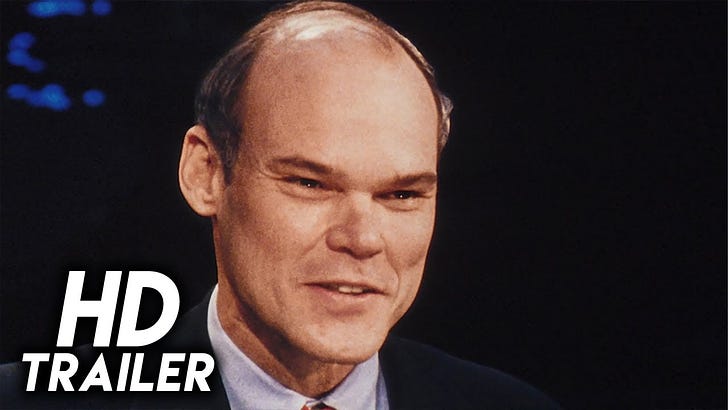'The War Room' at 30, and 'Shattered Glass' at 20
On the anniversaries of two movies that told 1990s stories: One about getting to Washington, D.C., and another about getting tossed out of it.
Chris Hegedus and D. A. Pennebaker’s The War Room was something that hadn’t really existed before: A cinema verite documentary about the behind-the-scenes of a presidential campaign.
The cameras followed Clinton’s campaign team during the New Hampshire primary, and eventually the general election, and had a front-row seat to some well-remembered history. We see Clinton sparring with primary opponents Paul Tsongas and Jerry Brown, dealing with (and denying) accusations that he’d had an affair with Gennifer Flowers, facing George H.W. Bush and Ross Perot, and ultimately pulling through.
In The War Room, which is now streaming on Max, we get the full Bill Clinton Experience: He was an extremely flawed man, but also an uncommonly skilled politician. And that would be the story of his presidency, which continued to have repercussions long after he left office.
The film, which arrived in November of 1993 – 30 years ago this week — was the start of several things. It helped to establish the myth-making around Bill Clinton’s political rise and presidency, while also cementing the political consultants at the center of the film, James Carville and George Stephanopoulos, as celebrities. We see them on the trail and also see their sides of conversations with reporters as they try to spin the news of the day.
There didn’t used to be such a thing as celebrity political advisers; in the days of Watergate and Iran-Contra, presidential advisors usually only became famous if they got arrested or indicted. But since then, it’s more the rule than the exception. These days, if someone runs a presidential campaign that goes the distance, or even one that doesn’t make it quite that far, that person will end up with a prominent media career, if they didn’t have one already.
Carville – who would go on to marry Mary Matalin, who worked on the Bush campaign that year — would essentially dine out on the 1993 campaign, and the film that depicted it, for the ensuing several decades. As for Stephanopoulos, who was still in his 20s at the time of the 1993 campaign, he’s seen in the film as a guest on ABC’s This Week, a show of which he’s now the host. And most movies about politics in the 1990s — starting with Michael J. Fox in The American President — would have a Stephanopoulos stand-in.
The book Primary Colors would provide a fictionalized version of these same events and the same dynamics, and Mike Nichols’ 1998 movie version — released at the absolute height of the Lewinsky scandal — would enshrine those events further for posterity.
The War Room was about the quest to get to DC, while another movie, set the same year as the arrival of Primary Colors, was set in that city, about a man who was (deservedly) exiled from there.
Not everyone in 2003 was excited about the prospect of a movie set at the Washington political magazine The New Republic in the mid-1990s, but I for one absolutely was. And when Shattered Glass arrived that November— 20 years ago this month — I wasn’t disappointed.
Shattered Glass, written and directed by Billy Ray, dramatized a journalism scandal from just a few years earlier, when Stephen Glass, a young hotshot journalist with The New Republic, was found to have fabricated several stories. Glass, like much of the magazine’s staff, was in his early 20s at the time.
Hayden Christensen, then and now best known for playing Anakin Skywalker in the Star Wars prequels, plays a much shiftier villain here- he’s portrayed as a brilliant but needy weirdo, constantly asking “Are you mad at me?” at even the lightest confrontation.
These colleagues (played by the likes of Chloe Sevigny and Melanie Lynskey) like him but are jealous- after all, how come they can’t come up with the sort of juicy stories he does? (For old-school TNR heads: Hank Azaria played the former editor, Michael Kelly, despite not looking anything like him, while Ted Kotcheff — director of First Blood, The Apprenticeship of Duddy Kravitz, and Weekend at Bernie’s — played magazine owner Marty Peretz.)
It’s a fascinating performance, with Glass portrayed as a character who’s nervous all the time, yet is confident enough to get away with lying about just about everything.
The film mostly focuses on “Hack Heaven,” a piece Glass wrote about a teenage hacker who had hacked into a software company called Jukt Micronics, and ended up hired by the company, in a scene that took place at the National Assembly of Hackers. However, the hacker, the company, and the conference were all fictitious. The film’s entire second half is the story unraveling, with new editor Charles Lane (Peter Saarsgaard.) The story unravels due to the work of two Forbes reporters (Steve Zahn and Rosario Dawson), who smelled a rat.
The process of the unraveling is presented fascinatingly, especially considering how early in the evolution of the web these events took place. A decade later, Glass’ stories probably would have fallen apart with days, rather than months. Shattered Glass arrived, in fact, shortly after the Jayson Blair scandal at the New York Times.
Glass was essentially banished from journalism after the scandal, and spent many of the ensuing years trying, and failing, to become a lawyer. This story, about Glass’ post-scandal life, could make its own movie.
Shattered Glass, which is streaming on the Roku Channel and other FAST streaming services, is first-rate as both a journalism movie and a Washington, D.C. movie.



